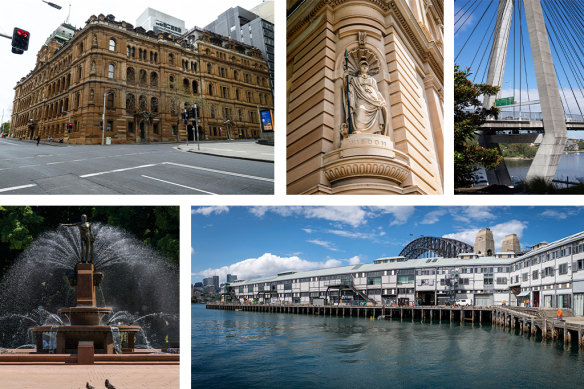Editorial
Heritage watchdog weak and largely asleep on the job
For an organisation charged with protecting the past for the future, Heritage NSW seems to have difficulty living in the present.
A report by the NSW Auditor-General has portrayed the state’s heritage watchdog as weak and largely ineffective. Sometimes it took up to 17 years to assess properties for protection. Its records were so poor it knew little about the true physical condition of hundreds of historic properties in its inventory. Almost 90 per cent of items on the register did not include a physical condition rating. Thirty-five per cent lacked any detailed physical description at all, making pursuit of any breaches difficult. Twelve per cent of records did not contain a statement outlining why the property was significant in the first place.

Some listed properties under the care of Heritage NSW.Credit: SMH Graphics
The audit office also uncovered systemic failures and huge information gaps in databases that had left Heritage NSW with “low visibility” and inadequate oversight of more than 1700 items on the state’s heritage register, with the body using its enforcement powers infrequently.
Growing out of legislation that resulted from the 1970s green bans to protect the environment, Heritage NSW sits within the Department of Planning and Environment and provides professional advice and administrative support to the Heritage Council to protect, conserve, manage, and celebrate heritage places across the state. Heritage listing affords formal legal protection for exceptional and rare examples of 19th- and 20th-century buildings, Aboriginal massacre or sacred cultural sites, schools, war memorials, shipwrecks, bridges, and gardens. Half of the listed properties are owned by government; the rest are managed by private owners and councils.
Assessments of properties for listing, protecting them from redevelopment or demolition, can take about five years on average. The audit did find that significant improvements in the turnaround of applications for major works on heritage items had been made in the past 18 months and delivered timely advice on heritage impacts in 90 per cent of cases.
However, for those items on the register, Heritage NSW lacked even the most basic information to assess the condition or risk of damage and disrepair to heritage-listed state jewels, let alone ensure compliance or detect potential breaches. Only 9 per cent of listing records had been updated in the past eight years and only 24 in the past three years. Most of its publications had not been updated in 10 years, some had not for more than 20 years.
Further, Heritage NSW did not necessarily have up-to-date contacts to reach owners to encourage compliance and lacked processes to identify ownership changes. The audit said its focus on improving customer service risked its capacity to oversee listed properties and support heritage values and its “low visibility” limited its capacity to monitor the condition of the state’s heritage assets. “The Department of Planning and Environment (Heritage NSW) does not have adequate oversight of state significant heritage assets,” the audit concluded. “Information gaps and weaknesses in certain assurance processes limit its capacity to effectively regulate activities affecting assets listed on the State Heritage Register. These factors also constrain its ability to effectively support voluntary compliance and promote the objects of the Heritage Act, which include encouraging conservation and adaptive re-use.”
For its part, Heritage NSW accepted the audit office’s eight recommendations and has started to rectify databases and said changes and improvements to processes were already under way.
Not unexpectedly, Minister for Heritage Penny Sharpe defended the agency, saying although there was a “lot to fix when it comes to heritage in our state”, its failings stemmed from chronic underfunding over 12 years and a lack of interest in heritage by the previous government, and legislative reform lay ahead.
Clearly reform is long overdue. There is no escaping the harsh reality that the audit report found Heritage NSW had in so many ways failed its mission. Our state’s best buildings and sites need and deserve better protection than this.
Bevan Shields sends an exclusive newsletter to subscribers each week. Sign up to receive his Note from the Editor.